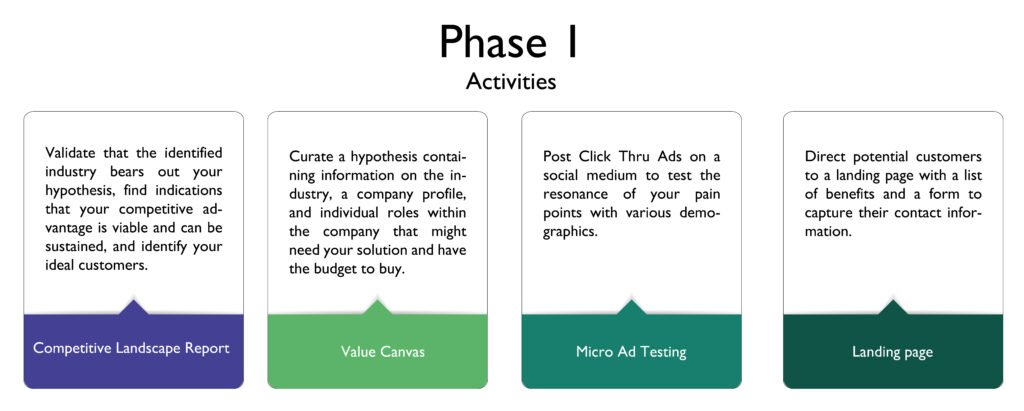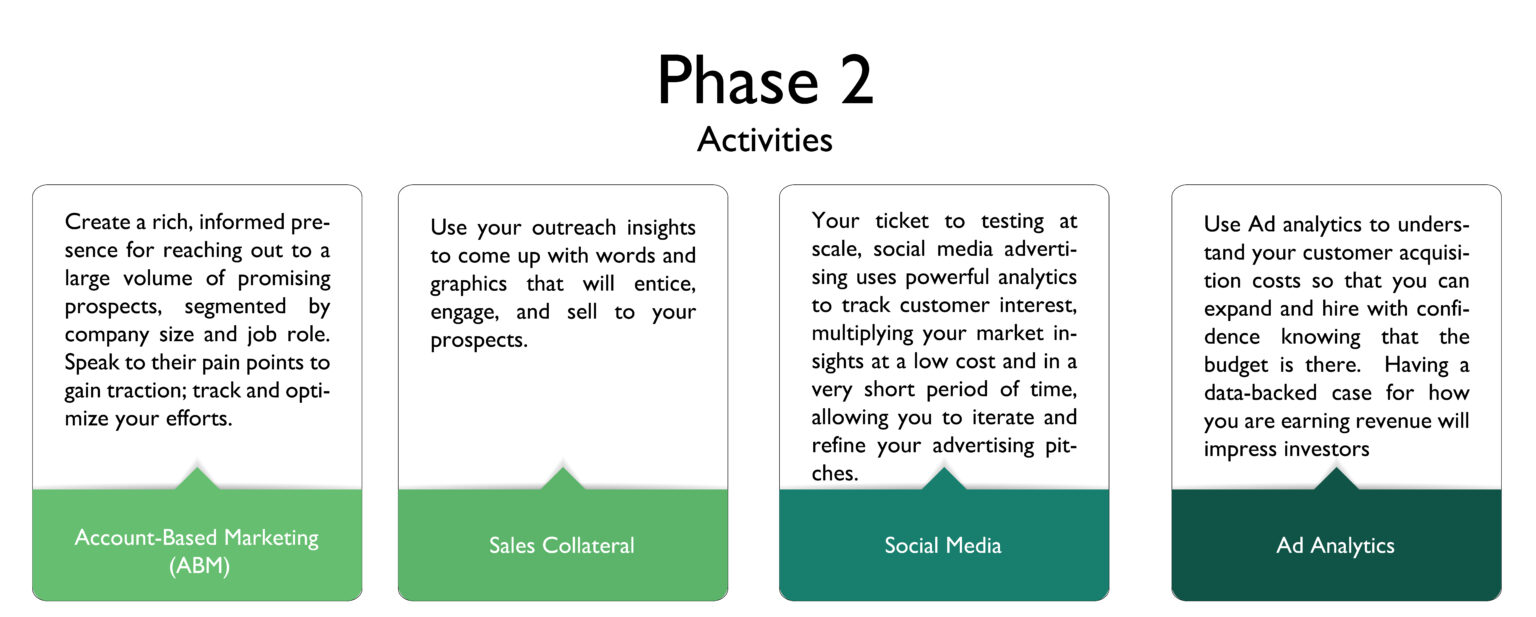Authors: Matthew Wahlrab and Craig Rochester
For founders who’ve developed a groundbreaking idea or technology, the next major challenge is successfully bringing the concept to the market. When seeking guidance on how and where to start, however, they’re pretty often met with vague, non-practical responses:
“You need to find your product-market fit.”
Sure, you think. I’ve heard that one a lot. But how?
“Make sure your approach is scalable.”
Again, heard it before. But how can I actually make that happen?
This vagueness and impracticality aren’t what founders need. What they do need are concrete approaches to facing these challenges, in practical detail. That’s the reason for this article series: sharing the step-by-step approach we use at Rapid Alpha to take founders from groundbreaking idea to successful market entry.
Taking startups from idea to market launch: Our 12-stage model



Phase 3
- Sales Outreach
Maximize your opportunities, turning introduction calls into successful relationships
- Branding
Consistent, data-backed style and messaging, priming you to grow effective and disciplined sales teams
- Web Page
Constructing a strategic, alluring, and functional online presence
- Search Engine Optimization (SEO)
Ensuring that you will be found by people searching for your solution
Exploring Phase 3 in detail

Sales Outreach
Maximize your opportunities, turning introduction calls into successful relationships
Our approach centers on enabling founders to reach out to prospects with confidence, knowing they have a pitch that is based on detailed insights into their target audience’s wants and needs. The Value Canvas and Sales Collateral you’ve developed over Phases 1 and 2 will have given you a rich awareness not only of the specific roles of your top prospects, but also of the colleagues around them, amplifying your outreach.
Let’s say you’ve secured a call with a head of R&D. They may be sold on your product, but, given their company’s profile, the head of IT may still need to be convinced. Knowing this before your call enables you to give the head of R&D talking points to use to help you put the head of IT’s mind at rest, and to preempt sticking points. Letting them know that integrations are included, for example, so that their IT team won’t lose hours, days, or weeks on integrating your product.
Including these research-driven plus points in your sales funnel enables you to lead with value and reassurance, enabling you to close deals faster.
Start low-stakes, aim high-stakes
Getting in front of your dream clients can be a challenge. Maximizing the opportunity when they agree to speak with you is essential — which can be a major source of stress for founders contemplating an important pitch.
One of the ways we position founders for success when pitching to major prospects is encouraging them to start small, with lower-stakes talks. These are essentially practice runs, where you can develop your skills and gain confidence, before going all-in on pitching to your dream clients.
Branding
Consistent, data-backed style and messaging, priming you to sell at high volumes
By developing a consistent style and messaging, you can instantly communicate to your clients and prospects that they’ve found their preferred solution provider. We create standards and guidelines for the fonts, color schemes, images, and tone of voice that will bring your brand to life, saving you serious time and removing from your to-do list tasks that may not be in your founding team’s comfort zone.
Leveraging data to build a brand that resonates
A challenge founders often face is separating their brand from themselves as an individual. Yes, your brand should speak to the part of you that makes the company you’ve created unique. However, you need to home in on the specifics of what it is about you as a founder, and what about your company really hits the mark with your target audience.
How? Using the insights you’ve gained from the Micro Ad Testing and the Landing Page you implemented in Phase 1 and your Account-Based Marketing (ABM) and Sales Collateral evolution in Phase 2. The feedback you gain throughout these stages will identify the graphics, color options, and wording that best guide your prospects to action, becoming the starting point to building a brand that both resonates externally and stays true to your company’s distinctive characteristics.
Thorough branding frameworks position your company to scale
With detailed guides covering your imagery and tone of voice, there’s no question about what your brand looks and sounds like. So you’re in a fantastic position to scale your content promotion — whether with an in-house hire or by outsourcing. You have total flexibility to choose how you allocate content creation resources, knowing you can provide instructions that have led to success in the past, and that are detailed enough to lead to outputs that align with your growing brand presence.
This guide library will also serve you well when you bring in a CMO (alongside the Value Canvas, Industry Landscape Report, ABM, and Sales Collateral insights generated in Phases 1 and 2). With this information in hand, you can be sure that your first marketing hire will be equipped to hit the ground running to scale your business. Setting them up to succeed will give them a springboard to opening up new channels and partnerships, rather than spending the first six months creating your marketing infrastructure.
Web page
Constructing your strategic, alluring, and functional online presence
A web presence is essential to attracting customers, but startup teams are often stretched thin on time and resources for developing the quality graphics and content needed for an aesthetic and fully functional website. We help you implement your fresh, data-driven branding rapidly, expertly, and at the opportune moment.
Don’t be overly hasty on your web presence: Insights help you build better
Creating an online presence might be at the top of your priorities, but it’s unwise to pour funds into a web page before you truly know what your audience needs to see on it. Technical information might be your comfort zone as a founder, and the aspect of your product that you’re most passionate about, but bits and bytes may not resonate strongly with your potential buyers.
Instead, consider speaking to their pain points and preferences, and incorporating all the insights you’ve gained from Phases 1 and 2of your go-to-market journey to build a web page that resonates with the narrative of your customer.
Search Engine Optimization (SEO)
Ensuring that you will be found by people who are looking for you or your product
In parallel with creating your on-brand web presence, we support you with analytics to determine what is drawing prospective customers to your site. Knowing this lets you present content that encourages engagement and action (and ultimately, generates sales). We also help you to consistently generate new content to improve your web and in-person pitch presence, feeding insights from your web page analytics into your sales collateral and sales outreach, and vice versa.
The challenge of SEO: Moving from catch-all to deal-close
The majority of SEO focuses on leading everyone entering specific search terms to your web page, regardless of whether they are profiles featured in your Phase 1 Value Canvas or not (in other words, Marketing Qualified Leads or MQLs).
However, if catch-all SEO is all you’ve got, you could have a tough time persuading these MQLs to take further action once on your website (that is, converting them to Sales Qualified Leads or SQLs, with actual interest in buying from you).
So, to complement your SEO, you need to build real muscle on your landing page. What imagery and content will be so compelling that they spur viewers to action, moving MQLs towards SQLs? The insights from our Phase 2 Ad Generation are crucial here, pinpointing the wording that best drives interested viewers to click. Working these keywords and phrases into both your SEO and landing page can help channel high-potential searchers and browsers to your site.
Replicate wording insights for maximum-efficiency content
You’re running ads that show you which phrases best persuade your target audience to click. You’re populating your website with these same insights. You’re evolving your pitches to reflect them too. And you are mirroring the language that your prospects actually use in your sales calls in your company’s written content.
You’re creating an ecosystem of content optimization, an evolving system of feedback and refinement. Effective words and phrases can become the basis for compelling, conversion-driving thought leadership pieces, webinar scripts, and adoption by others in the industry who may become evangelists for your ideas and your company.
Phase 3 round-up: Presenting
the insights you’ve gained to investors

From Phase 1 to Phase 3, you’ve built touchpoints with your potential customers, amassing significant data on what makes them tick — and buy. The insights you gain at each stage inform the optimization of the stages that come before and after, in a process that evolves from accumulative to iterative, generating continuous improvement.
The ability to present the hard data that has guided your decisions at every stage of your go-to-market process — from prospect outreach to branding — shows investors that the way you allocate your resources is extremely diligent and thoughtful. That you have a practical plan, process, and methodology that allows you to spend responsibly, save money strategically, and create greater ROI in the short, mid, and long-term time frames.
A scientific approach to go to market activities
Go-to-market doesn’t have to be guesswork: Rapid Alpha provides a data-driven structure to get you there. With clear indicators to show you what’s working and what isn’t at each stage, we test and optimize traction with you at every step to ensure that your resources are used efficiently and to maximum success. We guide founders to market success, faster.
We are Rapid Alpha.
To find out more, don’t hesitate to reach out to our team.


